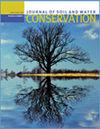Assessing the Agricultural Conservation Planning Framework toolbox in a Southern Piedmont landscape of the United States
IF 2.6
4区 农林科学
Q2 ECOLOGY
引用次数: 0
Abstract
The Agricultural Conservation Planning Framework (ACPF) is a geospatial decision support tool that was developed and is used in many areas of the Midwest of the United States to help with the prioritization and placement of conservation practices within agricultural watersheds. We evaluated the utility and extensibility of ACPF in two US Geological Survey 12-digit scale hydrologic units in the Southern Piedmont of North Carolina. The Southern Piedmont consists of less row crop agriculture and more pasture systems than the Midwest and has generally lower pollutant loads. Also, agricultural fields are comparatively smaller, irregularly shaped, and more sparsely distributed. For this study, local conservation experts were interviewed about conservation practices and their appropriate locations in the landscape. Interviewees demonstrated an extensive working knowledge of the land and producers on over 90% of the farmland. Many of the conservation practices identified by the local experts were “soil health” practices, such as cover crops or nutrient management, and are assumed in use before running ACPF. Results revealed that many of the conservation practices output by ACPF were not identified by the local experts in the Southern Piedmont watersheds due to their limited use in pasture conservation, conservation priorities, and landscape characteristics. Row crop agriculture was sparsely distributed in each study watershed and comprised less than 2% of the total catchment area. Contour buffer strips and grassed waterways were the conservation practices most identified by ACPF and were sited in 75% of cropped fields. A greater number of crop-related conservation practices (48 versus 15) were identified by ACPF than by local experts; however 80% of the conservation practices identified by the experts were outside the scope of ACPF and were mainly nutrient management or soil health practices. To evaluate ACPF for broader utility in the Southern Piedmont, alternative interpretations for existing outputs were considered: (1) ACPF “proxies” were identified to compare locally accepted practices with ACPF outputs that perform a similar function (e.g., strip cropping rather than contour buffer strips) and, (2) placing locally used conservation practices (e.g., exclusion fencing) based on existing ACPF data layers (hydrologically enforced flow paths). Alternative uses and interpretations surrounding ACPF outputs and data layers may provide opportunities for conservation planning outside the scope and intended use of ACPF in the Southern Piedmont.评估美国南部山前景观的农业保护规划框架工具箱
农业保护规划框架(ACPF)是一种地理空间决策支持工具,在美国中西部的许多地区得到开发和使用,以帮助确定农业流域保护措施的优先次序和位置。我们在北卡罗来纳州南皮埃蒙特的两个美国地质调查局12位数水文单位中评估了ACPF的实用性和可扩展性。与中西部地区相比,南部的皮埃蒙特地区由较少的行作物农业和更多的牧场系统组成,并且通常具有较低的污染物负荷。此外,农业用地相对较小,形状不规则,分布更稀疏。在这项研究中,采访了当地的保护专家,了解保护措施及其在景观中的适当位置。受访者对90%以上农田的土地和生产者都有广泛的工作知识。当地专家确定的许多保护做法是"土壤健康"做法,如覆盖作物或养分管理,并假定在运行ACPF之前使用。结果表明,由于ACPF在牧场保护、保护优先级和景观特征方面的限制,许多ACPF的保护实践成果没有得到当地专家的认可。行作物农业在每个研究流域分布稀疏,占总流域面积不到2%。等高线缓冲带和草地水道是ACPF最确定的保护措施,分布在75%的耕地中。与当地专家相比,ACPF确定了更多与作物有关的保护措施(48项对15项);然而,专家们确定的80%的保护做法不在ACPF的范围之内,主要是养分管理或土壤健康做法。为了评估ACPF在南山前更广泛的效用,考虑了对现有输出的替代解释:(1)确定了ACPF“代理”,将当地接受的做法与执行类似功能的ACPF输出(例如,带状种植而不是等高线缓冲带)进行比较;(2)基于现有ACPF数据层(水文强制流动路径)设置当地使用的保护做法(例如,隔离围栏)。围绕ACPF输出和数据层的其他用途和解释可能为ACPF在南皮埃蒙特的范围和预期用途之外的保护规划提供机会。
本文章由计算机程序翻译,如有差异,请以英文原文为准。
求助全文
约1分钟内获得全文
求助全文
来源期刊
CiteScore
4.10
自引率
2.60%
发文量
0
审稿时长
3.3 months
期刊介绍:
The Journal of Soil and Water Conservation (JSWC) is a multidisciplinary journal of natural resource conservation research, practice, policy, and perspectives. The journal has two sections: the A Section containing various departments and features, and the Research Section containing peer-reviewed research papers.

 求助内容:
求助内容: 应助结果提醒方式:
应助结果提醒方式:


